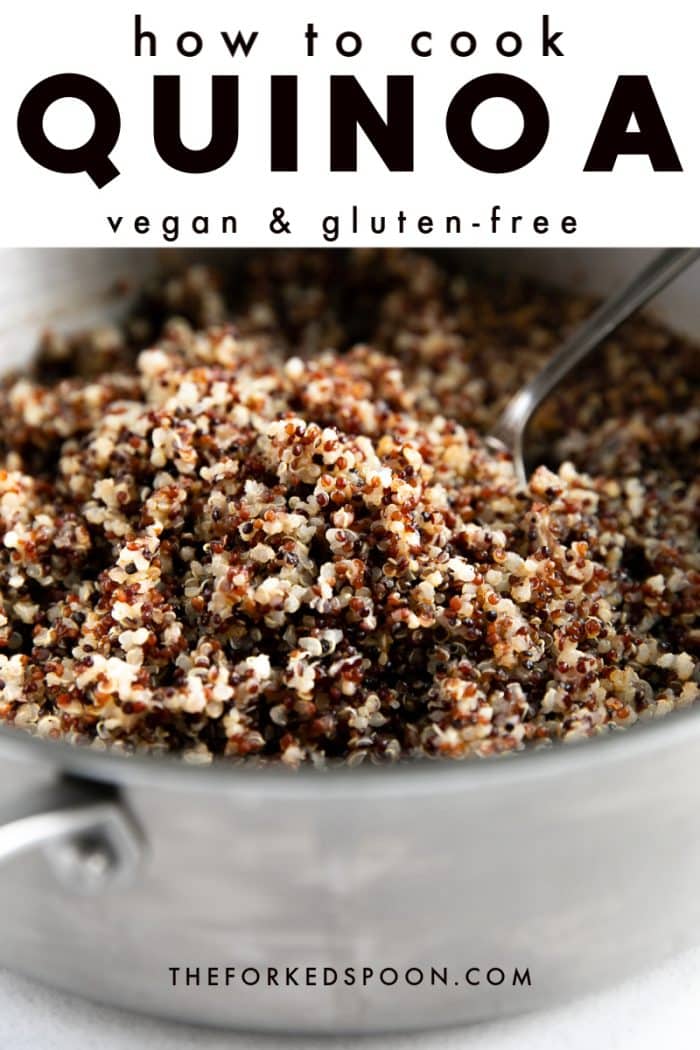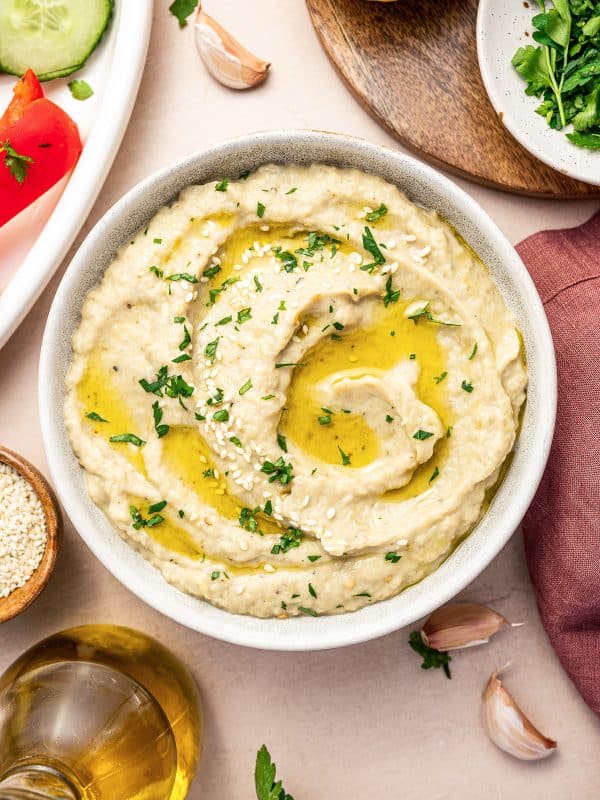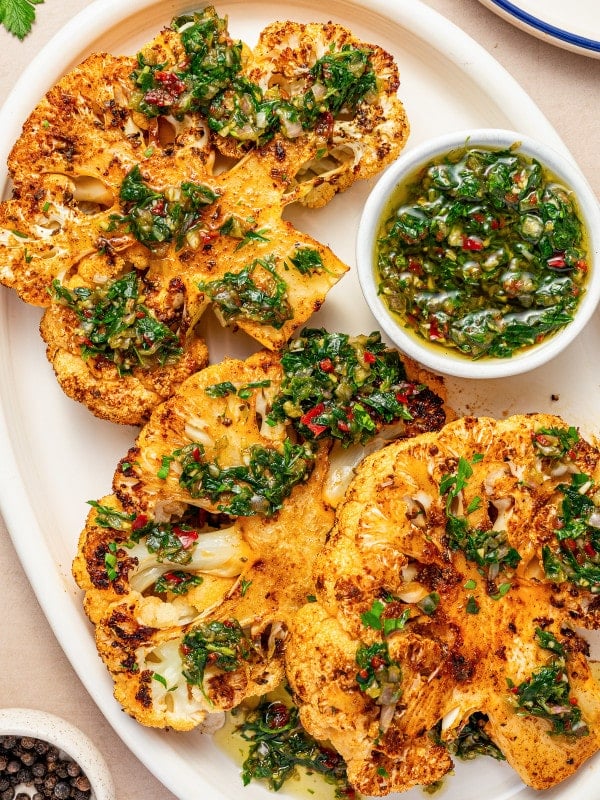This post may contain affiliate links. Please read our disclosure policy.
Learn how to cook quinoa that is perfectly light, fluffy, and flavorful every time with these easy step-by-step instructions and cooking tips. Ready in under 25 minutes, enjoy this gluten-free, vegan, and protein-rich “superfood” in bowls, salads, wraps, or as a healthy side dish.
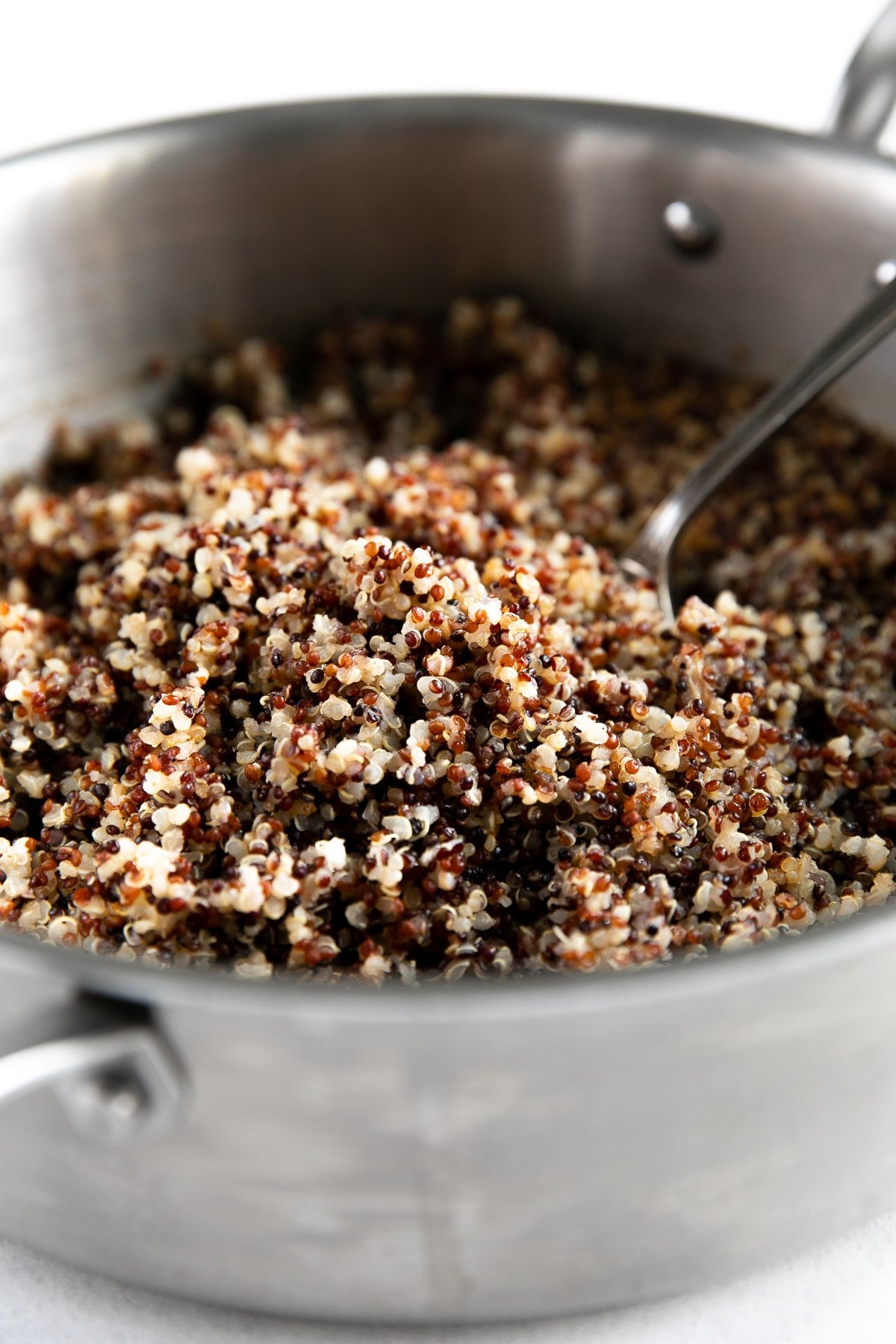
Nutty, flavorful, and incredibly versatile, quinoa is high in protein, gluten-free, and super easy to make. Delicious in soups, casseroles, salads, and wraps, you can even enjoy this fantastic whole grain “superfood” for breakfast drizzled with honey and milk.
A complete protein, quinoa contains all nine essential amino acids, making it a terrific substitute for rice, couscous, or pasta.
Table of Contents
What is Quinoa?
Quinoa (pronounced “kēnwä” or “KEEN-wah”) is a flowering plant grown for its edible seeds. When compared to many other grains, quinoa is higher in protein (containing all nine essential amino acids), dietary fiber, B vitamins, and minerals (source).
Technically, quinoa is not a grass, and therefore not a cereal grain, but rather a pseudo-cereal (source). A pseudocereal is any type of non-grass used in the same way as cereals. Their seeds are either ground into flour or used as cereal (all true cereals are grasses). Other types of pseudocereals include buckwheat, amaranth, and chia.
A modern-day “superfood,” quinoa was cultivated and consumed by the people of the Incan Empire, who considered it to be sacred and the “mother of all grains.”
Coming in three main types, red, white, and black, all quinoa is non-GMO and gluten-free, and while it is not technically a cereal grain, it is still considered a whole-grain food.
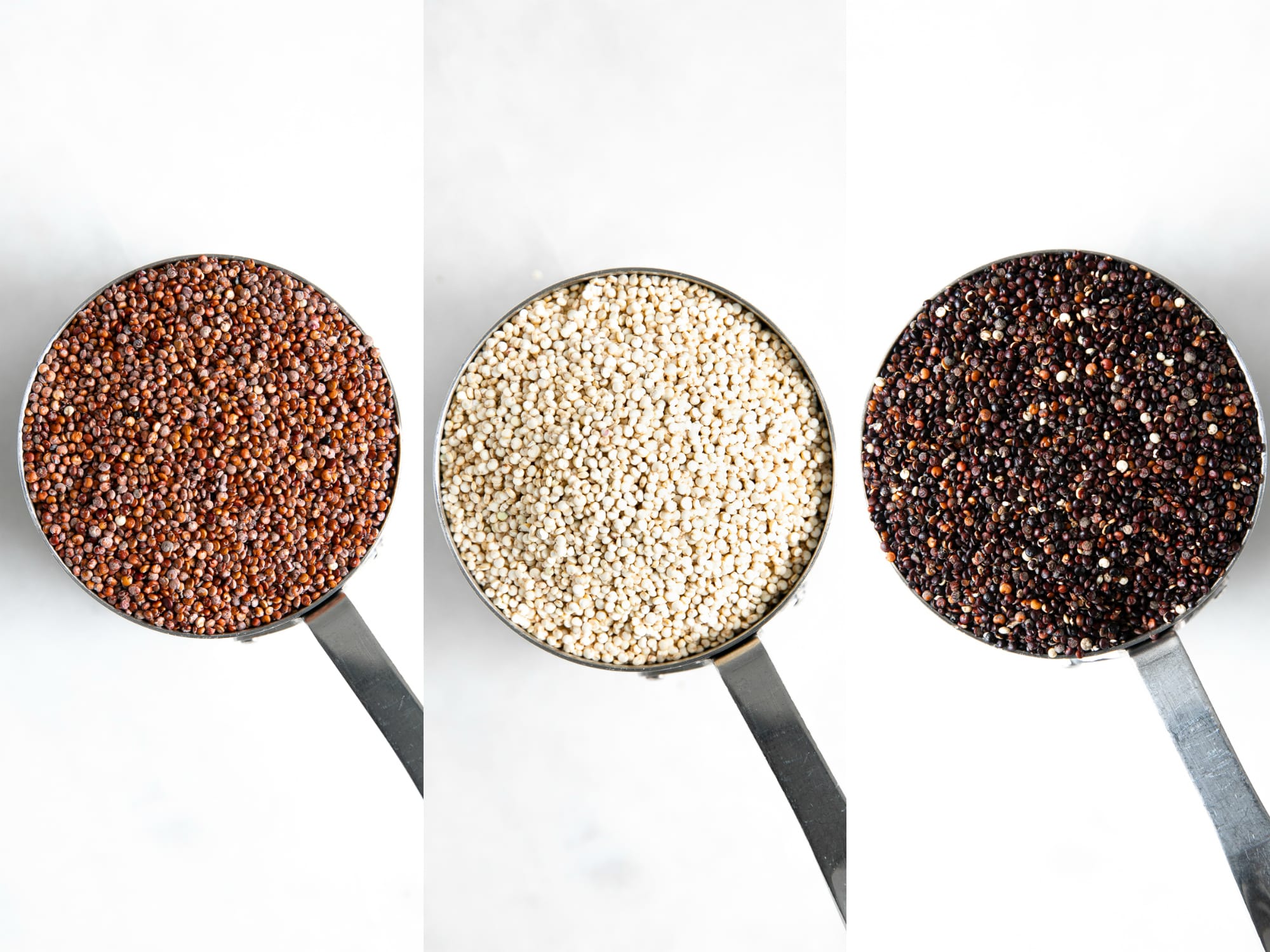
What are the Different Types of Quinoa?
According to the Whole Grains Council, there are approximately 120 known varieties of quinoa. However, the most common types of this whole grain are red, white, and black.
- Red quinoa: has a somewhat heavier, nuttier texture and taste. Given its heavier texture, red quinoa holds its shape better after cooking, making it a great choice for use in cold salads or dishes that could use a little extra color.
- White quinoa: is the most common variety found in stores. Generally, the lightest and fluffiest of the three after cooking.
- Black quinoa: the least common of the two, black quinoa has a similar texture to the red variety but has a somewhat earthier, sweeter taste when compared to white quinoa.
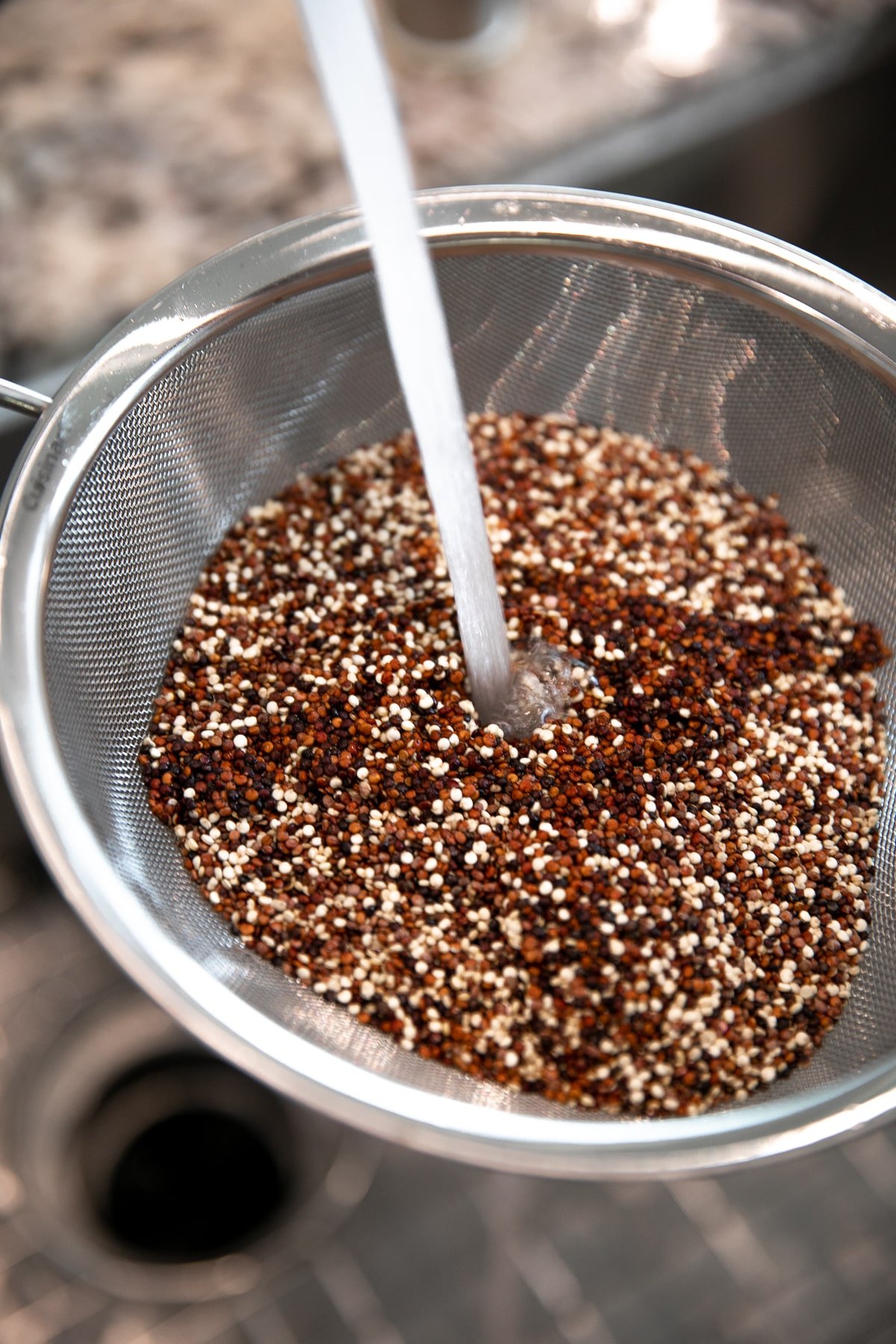
How to Cook Fluffy Quinoa
1. Rinse: Just like cooking rice, we need to rinse the dry quinoa before cooking. Place one measured cup of uncooked quinoa in a fine-mesh strainer. Rinse under cold, running water, then drain and set aside.
2. Toast: In a medium-sized pot or pan, set over medium to medium-high heat, add approximately two teaspoons of oil. Once the oil is warm, stir in any desired spices or flavors. I added ground cumin, ground onion, and ground garlic. Any added spices and herbs are completely optional. Add the drained quinoa and stir to coat in olive oil. Toast the quinoa, stirring continuously, for 1-2 minutes. Toasting helps accentuate the naturally nutty flavor in the quinoa.

3. Cook: The quinoa to water ratio is 1 cup quinoa to 1 and 3/4 cups water or other liquid. For this recipe, I added veggie broth, but feel free to include homemade chicken stock, beef broth, or bone broth. Increase heat to high and bring to a boil. Once boiling, reduce to low heat, then cover the pot and cook for approximately 15-20 minutes.
4. Steam: Do not remove the lid from the pot. Remove from heat and allow to rest for 5 minutes.
5. Fluff and Serve: Remove the lid and gently fluff with a fork. Season with salt and pepper, to taste, or season with fresh herbs, including freshly chopped parsley or cilantro.
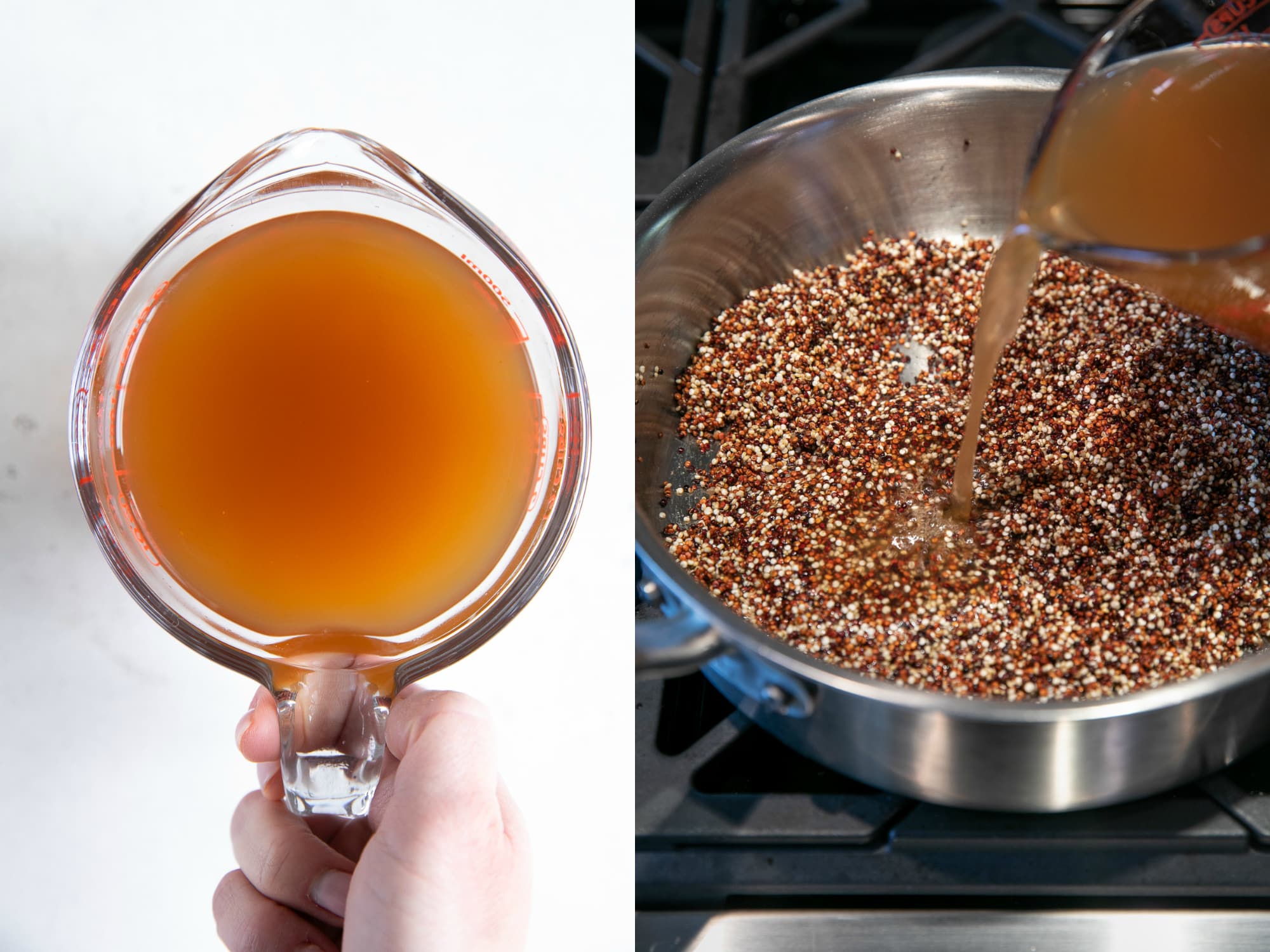
Frequently Asked Questions
Once cooked, quinoa will last for 4-5 days when stored in an air-tight container in the refrigerator.
Rinsing quinoa with water removes its natural coating, called saponin. Saponin makes it taste bitter and soapy. Most boxed quinoa sold here in the states comes pre-washed, so there’s no need for anything more than a light rinse.
For every one cup of dry quinoa, you will need 1 and 3/4 cups of liquid. Use water, or add a little extra flavor by replacing the water with vegetable broth or chicken broth.
Yes.
Nearly all of the bitterness comes from the outer coating, saponin. A short, yet vigorous, rinse in cold water should remove most, if not all, bitterness.
Yes. Use the same water to quinoa ratio and follow the manufacturer’s instructions on your rice cooker to cook your quinoa.

Quinoa Recipes and Uses
Salad: This is actually my favorite way to enjoy (and eat more!) quinoa. Make sure to fully cool your quinoa before adding it to any salad, especially if it’s filled with leafy greens like spinach. This beet, avocado, and quinoa salad is a great example of how to incorporate quinoa into salads and is one of my all-time favorite salads, ever.
Meal Prep: Prepare a big batch and add to your favorite meal prep meals, like these delicious chicken shawarma quinoa bowls or buffalo turkey meatballs. You can also freeze leftover quinoa for later.
To freeze quinoa,
- Cool completely
- Transfer single-serving portions to freezer-safe reusable bags
- Squeeze out as much air as possible
- Transfer to the freezer
Swap out the rice in your favorite casseroles: rice casseroles like this chicken broccoli casserole are absolutely delicious. Swap the rice for quinoa for an instant bump in protein and fiber without compromising on taste. Try this easy Mexican quinoa casserole or this BBQ chicken spaghetti squash casserole.
Add it to your holiday table: Stuffing may be a favorite come the holidays, but consider including this fall quinoa salad, vegetarian stuffed acorn squash, or butternut squash salad to your table.

More Delicious Side Dish Recipes,
Have you tried making Quinoa?
Tell me about it in the comments below! I always love to hear your thoughts. And tag me #theforkedspoon on Instagram if you’ve made any of my recipes. I always love to see what you’re cooking in the kitchen.
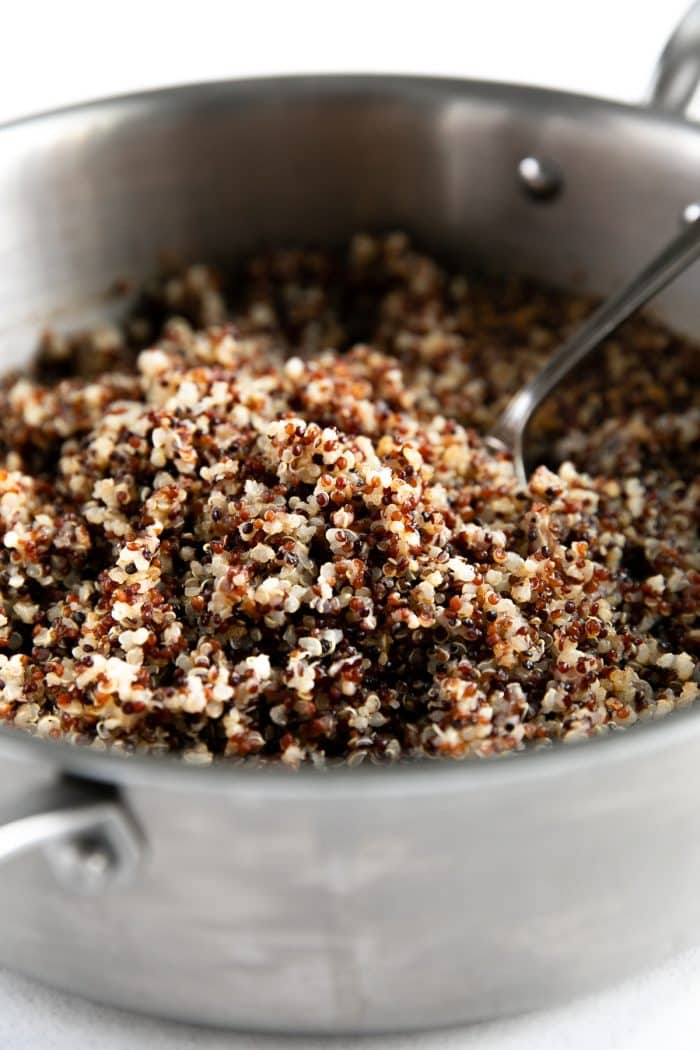
How to Cook Quinoa Recipe
Ingredients
- 1 cup quinoa
- 2 teaspoon olive oil
- ½ teaspoon ground cumin, (optional)
- ¼ teaspoon garlic powder, (optional)
- ¼ teaspoon onion powder, (optional)
- 1¾ cups water, or broth (vegetable broth or low-sodium chicken broth)
- ½ teaspoon salt
Instructions
- Place 1 measured cup of quinoa in a fine-mesh strainer. Rinse well with water, drain, and set aside.
- Heat 2 teaspoons of olive oil in a medium-sized pot or saucepan set over medium heat. Swirl to coat the entire surface of your pan. Stir in desired spices (optional) followed by the rinsed and drained dried quinoa. Toast the quinoa, stirring continuously, for 1-2 minutes.
- Add 1 and 3/4 cup vegetable broth (what I used), or water, low-sodium chicken broth, or even beef or bone broth. Increase heat to high and bring to a boil.
- Once boiling, reduce your stove to low heat. Season with salt and pepper. If I'm using broth (homemade or store-bought), I will start with 1/2 a teaspoon of salt. If I'm using water, I will add a full teaspoon of salt. Cover the pot and cook for approximately 15-20 minutes.
- With the lid still on, remove the pot from heat and allow it to rest for 5 minutes. Remove the lid and gently fluff with a fork. Season with any additional salt and pepper, to taste, or season with fresh herbs, including freshly chopped parsley or cilantro.
Notes
Nutrition
Nutrition information is automatically calculated, so should only be used as an approximation.
